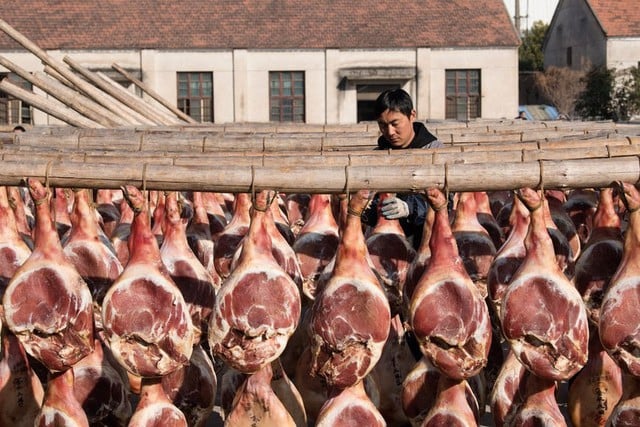The first-floor room in the castle-style building at the amusement park in Zhejiang province, eastern China, has a glass window facing down to the pigsty on the ground floor so guests can see the animals below, according to Hong Kong newspaper SCMP .
A video clip of the room and the unique view has been viewed 6 million times on Douyin, China's version of TikTok, since it was posted on June 25 by Zhejiang Tianmu News . Dubbed Jinhua's Disneyland, the theme park opens in 2021 to promote the breed, nicknamed "panda pigs" for their unique black heads and tails, with white bodies.

Young tourists watch pigs from the glass window of a thousand-dollar hotel room
This breed of pig – originally known as the “two-headed black pig” – has been particularly popular in China for at least 1,200 years as the source of traditional Jinhua cured ham, which ranks alongside Italy’s Prosciutto di Parma and Spain’s Jamón Ibérico.
Some believe it was Marco Polo who brought the secret of making smoked meat from Jinhua to Europe in the 13th century, leading to the development of the process outside of China.
The special breed of pig not only resembles the giant panda in appearance, but is also rare. A report by Qianjiang Evening News put the annual population of these pigs in Jinhua at 75,000 to 80,000, accounting for only 3 to 4 percent of the city's total pig population. Despite being famous for providing the best Jinhua ham, thanks to its firm meat and thin skin, local farmers have turned their backs on panda pigs in favor of foreign breeds that take nearly half the time to double in weight.

Traditional smoked pork leg made from Jinhua panda pig
The breed has become so rare that a farm in Japan that also breeds panda pigs has dubbed them “magic pigs.” To promote and preserve the famous pigs, the local government has developed a theme park in their honor. The site includes a museum dedicated to panda pigs…
Guests who book a pig viewing room can also take a panda pig home or enjoy pork for a year for 6,000 yuan ($830). In 2016, the Jinhua government spent 5 million yuan on research and development of panda pigs.
Source link























![[Photo] National Assembly Chairman Tran Thanh Man visits Vietnamese Heroic Mother Ta Thi Tran](https://vphoto.vietnam.vn/thumb/1200x675/vietnam/resource/IMAGE/2025/7/20/765c0bd057dd44ad83ab89fe0255b783)










































































Comment (0)